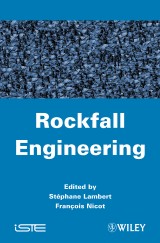Details

Rockfall Engineering
1. Aufl.
|
173,99 € |
|
| Verlag: | Wiley |
| Format: | |
| Veröffentl.: | 07.02.2013 |
| ISBN/EAN: | 9781118601525 |
| Sprache: | englisch |
| Anzahl Seiten: | 435 |
DRM-geschütztes eBook, Sie benötigen z.B. Adobe Digital Editions und eine Adobe ID zum Lesen.
Beschreibungen
Rockfall Engineering is an up-to-date, international picture of the state of the art in rockfall engineering.<br /> The three basic stages of rockfalls are considered: the triggering stage, the motion stage, and the interaction with a structure stage; along with contributions including structural characterization of cliffs, remote monitoring, stability analysis, boulder propagation, design of protection structures an risk assessment.<br /> Academic contributions are illustrated by practical examples, and completed by engineering contributions where practical purposes are thoroughly considered. This title is intended for engineers, students as well as researchers.
<p><b>Foreword xiii</b></p> <p><b>Introduction xvii</b></p> <p><b>Chapter 1. Geophysical Detection and Characterization of Discontinuities in Rock Slopes 1</b><br /> <i>Jacques DEPARIS, Denis JONGMANS, Stéphane GARAMBOIS, Clara LÉVY, Laurent BAILLET and Ombeline MERIC</i></p> <p>1.1. Introduction 1</p> <p>1.2. Geophysical parameters and methods 2</p> <p>1.3. Applications 19</p> <p>1.4. Conclusions 31</p> <p>1.5. Acknowledgments 32</p> <p>1.6. Bibliography 33</p> <p><b>Chapter 2. Remote Sensing and Monitoring Techniques for the Characterization of Rock Mass Deformation and Change Detection 39</b><br /> <i>Marc-Henri DERRON, Michel JABOYEDOFF, Andrea PEDRAZZINI, Clément MICHOUD and Thierry VILLEMIN</i></p> <p>2.1. Introduction 39</p> <p>2.2. Main issues 40</p> <p>2.3. Investigation and monitoring techniques 41</p> <p>2.4. Examples of applications 48</p> <p>2.5. Perspectives 57</p> <p>2.6. Conclusions 58</p> <p>2.7. Bibliography 58</p> <p><b>Chapter 3. Mechanical Stability Analyses of Fractured Rock Slopes 67</b><br /> <i>Véronique MERRIEN-SOUKATCHOFF, Jérôme DURIEZ, Muriel GASC-BARBIER, Félix DARVE and Frédéric-Victor DONZÉ</i></p> <p>3.1. Introduction 67</p> <p>3.2. Experimental study of rock joint behavior 68</p> <p>3.3. Failure computations of rigid blocks 72</p> <p>3.4. Overview of different stress-strain analyses 86</p> <p>3.5. An advanced stress-strain analysis of failure 92</p> <p>3.6. Conclusions 105</p> <p>3.7. Bibliography 106</p> <p><b>Chapter 4. Assessment of Constitutive Behaviors in Jointed Rock Masses from a DEM Perspective 113</b><br /> <i>Cédric LAMBERT and John READ</i></p> <p>4.1. Introduction 113</p> <p>4.2. Discrete Element Modeling of rock materials 115</p> <p>4.3. Representation of rock discontinuities 116</p> <p>4.4. Synthetic Rock Mass modeling methodology 125</p> <p>4.5. Analysis of specific mechanical behaviors: case studies 132</p> <p>4.6. Conclusions 138</p> <p>4.7. Bibliography 138</p> <p><b>Chapter 5. Methods for Predicting Rockfall Trajectories and Run-out Zones 143</b><br /> <i>Luuk DORREN, Ulrik DOMAAS, Kalle KRONHOLM and Vincent LABIOUSE</i></p> <p>5.1. Introduction 143</p> <p>5.2. Preparation of a rockfall trajectory study 148</p> <p>5.3. Definition of the release scenarios 153</p> <p>5.4. Rockfall models 154</p> <p>5.5. Plausibility check / validation of model output 164</p> <p>5.6. Fixing model results and translation into a readable map166</p> <p>5.7. Future improvements 167</p> <p>5.8. Bibliography 168</p> <p><b>Chapter 6. Rockfall Dynamics: A Critical Review of Collision and Rebound Models 175</b><br /> <i>Franck BOURRIER and Oldrich HUNGR</i></p> <p>6.1. Introduction 175</p> <p>6.2. Physical processes associated with collision and rebound 175</p> <p>6.3. Review of rebound models 181</p> <p>6.4. Perspectives and conclusions 203</p> <p>6.5. Bibliography 203</p> <p><b>Chapter 7. Rockfall Hazard Zoning for Land Use Planning 211</b><br /> <i>Vincent LABIOUSE and Jacopo Maria ABBRUZZESE</i></p> <p>7.1. Introduction 211</p> <p>7.2. Rockfall zoning for urban development planning 212</p> <p>7.3. Zoning methodologies at the regional/valley scale 222</p> <p>7.4. Zoning methodologies at the local scale 224</p> <p>7.5. Sources of uncertainties and differences in hazard zoning results 237</p> <p>7.6. Implications of zoning results in land use planning 243</p> <p>7.7. Conclusions 247</p> <p>7.8. Acknowledgments 249</p> <p>7.9. Bibliography 249</p> <p><b>Chapter 8. Rockfall Quantitative Risk Assessment 255</b><br /> <i>Jordi COROMINAS and Olga MAVROULI</i></p> <p>8.1. Introduction 255</p> <p>8.2. Objectives of the QRA 261</p> <p>8.3. Assessment of the rockfall risk components 266</p> <p>8.4. Examples of rockfall risk 290</p> <p>8.5. Bibliography 296</p> <p><b>Chapter 9. Multi-scale Analysis of an Innovative Flexible Rockfall Barrier 303</b><br /> <i>Ayman TRAD, Ali LIMAM, David BERTRAND and Philippe ROBIT</i></p> <p>9.1. Introduction 303</p> <p>9.2. Presentation of rockfall protection nets 304</p> <p>9.3. Presentation of tools used for the numerical simulation 306</p> <p>9.4. Characterization of the net 308</p> <p>9.5. Characterization of the energy dissipators 321</p> <p>9.6. Full scale test on the barrier 328</p> <p>9.7. Conclusion and perspectives 340</p> <p>9.8. Bibliography 340</p> <p><b>Chapter 10. A New Design Method for Rockfall Shelters Covered by Granular Layers 343</b><br /> <i>Francesco CALVETTI and Claudio DI PRISCO</i></p> <p>10.1. Definition of the impact phenomenon 343</p> <p>10.2. Real scale experiments 345</p> <p>10.3. An uncoupled approach for the definition of impact actions 359</p> <p>10.4. Conclusions 371</p> <p>10.5. Acknowledgments 372</p> <p>10.6. Bibliography 372</p> <p><b>Chapter 11. Design Procedure for a Three-Layer Absorbing System in Rockfall Protection Galleries 375</b><br /> <i>Norimitsu KISHI and Hisashi KON-NO</i></p> <p>11.1. Introduction 375</p> <p>11.2. Standard impact design formula for sand cushion 376</p> <p>11.3. Absorbing performance of sand cushion and TLAS 379</p> <p>11.4. Design concept for TLAS 383</p> <p>11.5. Estimate of impact energy transmitted to EPS bottom layer 386</p> <p>11.6. Design of reinforced concrete core slab 387</p> <p>11.7. Estimate of required thickness of EPS bottom layer 388</p> <p>11.8. Estimate of impact force transmitted to gallery roof slab 390</p> <p>11.9. Verification of proposed design procedure 390</p> <p>11.10. Conclusion 390</p> <p>11.11. Bibliography 392</p> <p><b>Chapter 12. Ground Reinforced Embankments for Rockfall Protection: From Real Scale Tests to Numerical Modeling 393</b><br /> <i>Daniele PEILA</i></p> <p>12.1. Introduction 393</p> <p>12.2. Full-scale tests on embankments 397</p> <p>12.3. Numerical modeling of ground reinforced embankments 411</p> <p>12.4. Conclusions 422</p> <p>12.5. Acknowledgments 422</p> <p>12.6. Bibliography 422</p> <p>List of Authors 427</p> <p>Index 433</p>
<p><strong>Stéphane Lambert</strong> is a Research Engineer at CEMAGREF, Grenoble, France. His research are mainly on protection structures, natural hazards and geosynthetics. <p><strong>François Nicot</strong> is a Researcher at CEMAGREF, Grenoble, France, and an Executive Member of the International Society for Soil Mechanics and Geotechnical Engineering (ISSMGE). His contributions mainly concern the mechanical behavior of granular geomaterials. He is also Editor-in-chief of the <em>European Journal of Environmental and Civil Engineering</em>.

















